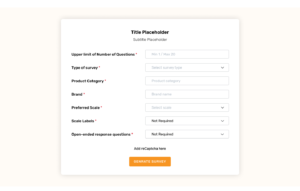Surveys are a great way to gather meaningful insights from your audience. They can help you understand their needs, preferences and opinions. However, writing a survey that yields reliable and accurate data is not as easy as it seems. There are several common mistakes that can impact the quality of the data you collect. In this blog post, we will cover 11 common mistakes in writing a good survey. We will discuss why survey writing is important, how to avoid asking the wrong questions, and not considering response bias. We will also dive into poor survey structure and answer options and scales. By the end of this post, you will have a clear understanding of what mistakes to avoid while creating surveys that deliver actionable insights for your business or organization.
Introduction
A well-designed survey is crucial for collecting accurate data. Poorly designed surveys can lead to biased and unusable data, resulting in a waste of time and resources. Mistakes in design are common and can significantly impact the effectiveness of your survey. It is important to test and refine your questionnaire before distributing it to ensure that it is error-free.
Some common mistakes to avoid when designing a survey include unclear questions, improper formatting, and inadequate testing. To create an effective questionnaire, it is essential to pay attention to detail and take the time to carefully craft each question. Testing your survey with a small sample group can help identify any issues or misunderstandings that may arise. By avoiding these common mistakes, you can ensure that your questionnaireyields accurate and useful data.
Why survey writing is important?
When it comes to gathering data and insights from a targeted audience, surveys are a valuable tool. That’s why effective survey writing is so important – it can help ensure that the data collected is relevant, accurate, and useful.
On the other hand, poorly written surveys can lead to biased or misleading results, wasted time and resources, and missed opportunities for valuable insights.
By taking the time to write a good survey, you can improve response rates, increase data quality, and ultimately make better decisions. So whether you’re conducting market research, measuring customer satisfaction, or gathering feedback on a new product or service, investing in effective questionnaire writing is crucial for success.
If writing a survey from scratch is intimidating use our AI survey builder to build one for you instantly.

Common mistakes that impact the quality of survey data
Surveys are a popular tool for gaining insights into customer preferences, opinions, and behaviors. However, there are several common mistakes that can impact the quality of survey data. These mistakes include using leading questions that can sway respondents’ answers, asking unclear or confusing questions which may lead to inaccurate responses, and using too many open-ended questions that can be difficult to analyze.
Other common mistakes in questionnaire design include not testing it before launching it, not providing enough context or instructions which may result in incomplete or irrelevant responses, and not considering the target audience when designing the questionnaire. By avoiding these mistakes, survey data can be more accurate and useful. It’s important to take the time to carefully design and test your questionnaire to ensure that you get the most out of your data collection efforts.
#1 Asking the Wrong Questions- Biased, Jargon-filled, Double Barreled, Double Negative Questions

Good questions are the building blocks of a good questionnaire. The question wording can make or break a questionnaire. Therefore, it is important to ensure that questions are clear, concise, and easy to understand so that respondents can provide accurate answers.
- Avoid leading questions or those that suggest a particular answer. Leading questions biases the responses and may not provide an accurate view of the respondent’s opinion. Similarly, avoid using jargon or technical terms that are difficult to understand for the average respondent. A few examples of leading questions include:
“Don’t you agree that our product is the best on the market?” or
“Do you think our competitor’s product is inferior to ours?”
- Avoid phrasing questions with a lot of jargon, technical terms or abbreviations. They effect the comprehension of the question and hence the response to it. Even when these terms are often used in your industry, sometimes what they mean to different people may vary. This inconsistency also impacts the quality of data collect.
- Double-barreled questions are those that ask about two things at once, making it difficult for respondents to provide a clear answer. Including both in the same question can push the respondent to either evaluate one or to skip the question altogether. For example,
“How satisfied are you with the quality of our products and customer service?” Instead, split up the question into two separate ones.
“Did you like the product when you used it today? Yes/ NO” Instead, ask if the product was used today and follow up on the experience today only if they did like the product
- Double negative questions are those that use negative phrasing and can be confusing for respondents. For example,
“Do you not agree that our customer service is poor?” Instead, rephrase the question as a positive statement like, “How satisfied are you with our customer service?”
2 Writing unclear or many open-ended questions
When it comes to writing a good questionnaire, asking the right questions is crucial. However, it’s equally important to avoid writing unclear or too many open-ended questions. While open-ended questions can be valuable for gathering detailed feedback, too many of them can overwhelm respondents and lead to incomplete surveys. Closed-ended questions, such as multiple-choice or Likert scale questions, may be more appropriate for certain types of surveys.
Why does too many open-ended questions overwhelm respondents? Open-ended questions can be time-consuming to answer and may require more thought and effort from respondents. When there are too many open-ended questions, it can lead to survey fatigue and cause respondents to rush through or skip questions, resulting in incomplete or inaccurate data.
But, don’t drop all open-ended questions from your surveys. They are a powerful tool to gather specific feedback and insights that cannot be obtained through closed-ended questions. When writing open-ended questions, make sure they are clear and focused on a specific topic or aspect of the product or service being surveyed. Limit the number of open-ended questions and balance them out with closed-ended questions to ensure a well-rounded survey that is easy for respondents to complete.
#3 Focusing on too many irrelevant or sensitive topics
One of the most common mistakes when creating a questionnaire is asking the wrong questions. This can include focusing on too many irrelevant or sensitive topics that may not provide useful insights. Most effective survey questions are those which are easy to understand, answer and pertain to metric that helps directly the survey objective.
It’s important to ensure that survey questions are clear-cut, concise, and easy to understand for respondents. Additionally, it’s important to avoid using leading or biased questions that may influence responses and skew results.
When crafting survey questions, be mindful of personal questions that may put respondents at unease and affect their willingness to participate in future surveys. In order to prioritize the most important questions, keep the questionnaire length reasonable. By taking care to ask relevant and appropriate questions, you can improve the quality and accuracy of your survey results.
#4 Not Considering Response Bias
Response bias is a common mistake in survey writing. This happens when questions are worded in a leading or confusing manner, which can skew the responses. To avoid this, it’s important to use clear and concise language that is easily understood by respondents. Avoid using jargon or technical terms that may not be familiar to everyone.
In addition, incorporating open-ended questions alongside closed-ended questions can provide more detailed feedback from respondents. Pretesting your survey with a sample group before distributing it to a larger audience can help identify any potential response bias issues and ensure that your survey is effective in gathering accurate data. By considering response bias and taking steps to prevent it, you can make sure that your survey results are reliable and useful.
#5 Leading questions that steer participants in a certain direction
One common mistake to avoid when writing a survey is not considering response bias, which can be caused by leading questions. Leading questions can influence participants’ responses and skew the results of your survey. To avoid this, it’s important to use neutral language and avoid making assumptions. Additionally, make sure the wording of each question is clear and easy to understand.
Another way to avoid leading questions is by using multiple-choice questions or rating scales, which eliminate ambiguity. However, it’s also important to allow for open-ended questions that give participants the opportunity to share their thoughts in their own words. By taking these steps, you can ensure that your survey results are accurate and representative of your target audience’s opinions and experiences.
#6 Using complex vocabulary or technical jargon that participants may not understand
When creating a survey, it’s important to avoid using complex vocabulary or technical jargon that participants may not understand. This can lead to inaccurate responses and ultimately undermine the quality of the survey. Using clear and concise language ensures that respondents understand the questions being asked and are able to provide accurate answers.
It’s also important to consider the audience when developing a questionnaire and use language that is appropriate for them. Avoid leading questions or questions that are too general, as they may result in biased responses. Additionally, including too many open-ended questions can lead to respondent fatigue, resulting in incomplete surveys. By carefully considering these factors, you can help ensure
that your survey is effective and provides valuable insights into your audience’s opinions and attitudes.
#7 Asking questions that are too personal or invasive
When creating a survey, it’s important to be mindful of response bias, which can occur when respondents answer questions in a way that is not truthful or accurate. One common mistake that can lead to response bias is asking questions that are too personal or invasive, which can make respondents uncomfortable. To avoid this, it’s important to only ask questions about sensitive topics if they are relevant to the survey’s purpose.
In addition, ensuring that questions are clear and easy to understand will reduce confusion and increase accuracy. Consider using skip logic to avoid asking irrelevant or repetitive questions. By taking these steps, you can help to minimize response bias and create a more effective survey.
# 8 Poor Survey Structure
One of the most common mistakes in creating a good survey is poor structure. Poorly structured questionnaires can result in biased or confusing questions that may not produce meaningful data. When creating a survey, it’s important to avoid leading questions and use clear and concise language to minimize confusion. Additionally, every question should be relevant to the survey’s purpose and goals.
Lastly, ensure you use appropriate question types like multiple-choice, open-ended, or ranking questions depending on the type of information you’re looking for. By following these guidelines, your survey will be better organized, more efficient, and ultimately produce more accurate results.
Read our blog on the best way to prioritize your survey questions.
#9 Not organizing questions in a logical way
One of the most common mistakes in writing a good survey is poor questionnaire structure. One aspect of this is not organizing questions in a logical way, which can negatively impact response rates and the quality of data collected. Starting with easy, non-threatening questions can help respondents get comfortable and feel more willing to provide honest and thoughtful responses later
- Grouping related questions together can also make it easier for respondents to understand the purpose of the survey and stay engaged throughout.
It’s important to avoid leading or biased questions that could pressure respondents into giving certain answers. Additionally, using clear and concise language can help make sure that respondents understand the question and are able to give accurate responses. By keeping these points in mind when structuring a survey, you can set yourself up for success and collect valuable data for your research or business needs.
#10 Not providing clear instructions on how to answer

When it comes to creating a good survey, poor structure can be a major issue. One common mistake is not providing clear instructions on how to answer the questions. It’s important to make sure that respondents understand what is being asked of them and how to provide an appropriate response. Clear and concise instructions can help with this, as well as providing examples of what constitutes a good or bad response. Additionally, it’s essential to be transparent about which questions are mandatory and which are optional.
Standardized response options, such as multiple-choice or Likert scales, can also be helpful in ensuring that respondents are able to answer the questions easily and accurately. By providing clear instructions and standardized response options, you can minimize confusion and ensure that your survey results are accurate and useful.
#11 Answer Options and Scales
Answer options and scales are crucial components of a good survey. It is essential to use clear and concise language that avoids technical jargon, and answer options should be mutually exclusive. To obtain reliable data, it’s important to provide a balanced range of response options that are consistent throughout the survey. Double-barreled questions and leading responses should be avoided because they can introduce bias into the results.
An “Other” option for open-ended responses is also a good idea as it allows respondents to express themselves more freely. The order in which answer options are presented can also influence the responses received, so take care when arranging them. One way to ensure that your survey is
effective is by pilot testing it before going live. This will help you identify any issues with wording, answer options or scales, enabling you to refine the survey before launching it.
#12 Providing too few or too many answer options
When it comes to creating a good survey, the answer options and scales you provide can greatly impact the quality of responses you receive. Providing too few answer options can limit the respondent’s ability to express their true opinion, while providing too many options can be confusing and overwhelming. It’s important to strike a balance between providing enough options while also keeping it simple and easy to understand.
One way to provide more nuanced responses is by using a scale or rating system. This allows respondents to provide more detailed feedback without being overwhelmed with too many choices. Additionally, pre-testing your survey with a small sample group can help identify any issues with answer options and scales before sending it out to your full audience. By taking the time to carefully consider your answer options and scales, you can ensure that your survey provides valuable insights and data for your business or organization.
#13 Using biased or leading answer options
Answer options and scales are crucial components of a good survey, but it’s important to avoid using biased or leading options that can skew your results. Biased or leading answer options use loaded words or phrases that suggest a certain answer, which can lead to inaccurate data. Instead, use neutral language and offer a range of options for respondents to choose from.
To ensure the clarity and neutrality of your answer options, it’s important to test your survey with a small group before sending it out. This will help you identify any potential biases or confusion in the wording of your questions. By taking these steps, you can create a survey that yields accurate and meaningful data.
#14 Not using consistent scales throughout the survey
When designing a survey, it’s important to pay close attention to the answer options and scales used. One common mistake is not using consistent scales throughout the survey. Using inconsistent
scales can lead to confusion and inaccurate data. To avoid this, it’s crucial to use the same scale throughout the survey for questions that are similar in nature.
Mixing scales such as using a 1-5 scale for some questions and a Yes/No response for others should also be avoided. Instead, consider using standard rating scales such as Likert or Semantic Differential scales to maintain consistency. By using consistent scales, respondents will have a better understanding of the survey, resulting in more accurate responses. So, when designing your next survey, remember to keep answer options and scales consistent throughout the entire survey to ensure reliable and meaningful results.
#15 Overall, Making the Survey Too Tiring
Survey fatigue is real. It refers to the exhaustion or fatigue experienced by respondents who have to complete long, tedious surveys. This can lead to respondents rushing through questions or quitting the survey altogether, resulting in inaccurate data.
To avoid survey fatigue, keep your surveys short and focused on a specific topic or theme. Limit the number of questions and answer options to only what is necessary to obtain meaningful data. Avoid using jargon or technical terms that may be confusing for some respondents.
Certain kind of questions induce more fatigue than others. Too many open ended questions or matrix questions can make a survey more tiring, so it may be helpful to limit the use of these types of questions. Good survey questions are simple, clear, to-the-point and easy to answer.
To keep respondents engaged, consider using visual aids such as images or videos. You can also include some simple and fun questions to break up the monotony of the survey.
By keeping your survey concise and engaging, you can minimize survey fatigue and maximize response rates, resulting in more accurate and meaningful data.
The importance of avoiding these common mistakes in survey writing
Answer options and scales are critical components of any survey as they significantly impact the quality of data collected. However, many common mistakes can be made when designing them. Some of these mistakes include using unclear or biased answer options and not providing enough response options for certain questions. Additionally, it’s important to use balanced scales that offer both positive and negative options to avoid skewing results. Using too many scale points or not providing clear instructions can also lead to confusion among respondents.
Avoiding these mistakes in survey writing is essential because it ensures that the survey accurately reflects the opinions and feedback of the target audience. By taking time to design clear and unbiased answer options and scales, you can collect accurate and reliable data that can be used to make informed decisions.
Final tips for writing a successful survey
When it comes to designing answer options and scales in your survey, it’s important to keep a few things in mind. Avoid overlapping or confusing options that could lead to inaccurate results. Additionally, using a balanced scale can help reduce bias in your survey and provide more accurate data.
It’s also a good idea to include an “other” option for open-ended answers that may not be covered by the provided options. However, try not to include too many scales or response options as this can overwhelm respondents and decrease response rates.
Keep the channel through which you are going to distribute the survey in mind as well. If the survey would go as an email signature, you can have only one questions. If you are going to send a survey link through the email, on the other hand, you can have a lot more question. A WhatsApp or FB Messenger survey can be made faster by using buttons and list if you make the answer choices short and limit their numbers. An AMP email survey can have 5-6 quick question which visual elements. Even when it comes to surveys- medium is the message.
Make the surveys engaging. You will not interrogate you customer if you met them in real life. Why would you do something like that in a survey. Make the survey engaging and conversational. Add
personalization, use visuals and emojis to break text overload, keep the tone of the questions friendly and respectful.
As a final tip for writing a successful survey, consider pre-testing it with a small group of people before sending it out to a larger audience. This can help identify any potential issues with the survey design and ensure that you are collecting the most accurate data possible.
To read more about the best practices in survey writing, read our ultimate guide on writing good surveys.
Conclusion
A good survey is not only informative and useful, but it is also easy to answer. Follow these simple tips to ensure a high-quality survey and reduce the chances of survey errors. By following these guidelines, you can avoid common mistakes that can impact the data collected and lower the overall response rate. Don’t hesitate to get in touch with our team of experts if you have any questions or concerns.





